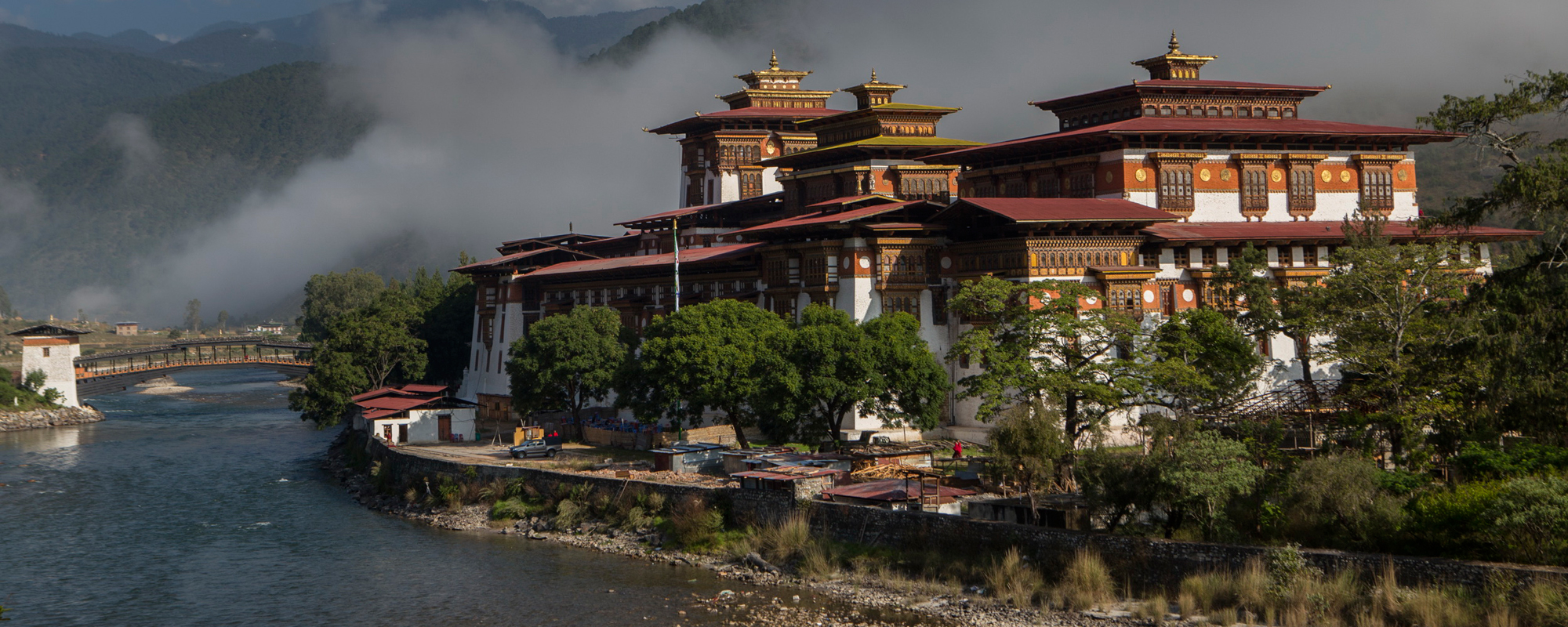About Bhutan

About Bhutan
Nestled in the Himalayas and between territories of more than two billion people of India and China lies a nation described as having mystique, magic, mystery – The Last Shangri – La.
Bhutan or Druk Yul (The Land of the Thunder Dragon) with verdant valleys, breathtaking mountain views, rich forests, pristine and pure water, streams, cliffs, that challenge, and monasteries that inspire peace dot its landscape.
Bhutan is a photographer`s paradise. The country`s stunning landscape and natural beauty are a joy to behold, captured in all its purest glory in the celluloid. Whether it is a majestic snow laden mountain, or a sparkling waterfall gushing down a steep ravine, or a sunset cast against an incandescent horizon, Bhutan is nature at it` s best – pristine, wonderful, and a rarity in the world.
Bhutan has remained a country where age old customs and traditions are still part of everyday lives of the people, even while modernization, development and the strains of global influence are felt more and more.
Happiness is a place
For a world long accustomed to measuring progress by the conventional yardstick of Gross National Product, the idea of Gross National Happiness became an attraction to the policy makers of the world.
Bhutan`s over- arching developmental philosophy of Gross national Happiness is founded on the belief that the profound needs of human beings are not necessarily material or physical, but there are other deeper dimensions of Life – natural, social, cultural, spiritual, psychological, aesthetic, moral, – that make life worthwhile and meaningful, and they need to be nurtured.
The main goal in life for Bhutanese people is Happiness. Even the mandate of modern Bhutanese state is Gross National Happiness. In translation, this means that economic development, a goal for much of humanity, is only a means to the real goal of happiness. Bhutan`s Brand tagline ‘Happiness is a Place’ simply assures that happiness can be found in simple things and these simple things can be found anywhere and in anything.
A Spiritual Nation
As the kingdom`s history is characterized by religious landmarks, the influence of religion is highly visible in everyday life of the lay population. Bhutan is a spiritual nation. Hundreds of sacred monasteries, stupas, religious institution, prayer flags and prayer wheels which dots the countryside provide a strong infrastructure and atmosphere for the teachings of their living faith.
In both urban and rural Bhutan, religious ceremonies and rituals are performed regularly and with reverence. The horoscope of Bhutanese life is drawn from the scriptures. National and regional festivities, coinciding with the seasons, are major for the entire population the year round. The Buddhist world thus regards the Kingdom with special importance as the last bastion of Mahayana Buddhism.
A Rich Culture
Bhutanese language and literature, the arts and crafts, ceremonies and events, and basic social and cultural values draw their essence from religious teachings. The tradition of fine art is alive today, manifested, for example, in exquisite traditional paintings visible on monasteries and houses, skillfully enhancing the architecture.
Architecture is also a significant feature of the Bhutanese identity. The combination of engineering skills and aesthetic beauty is unparalleled in structures, from the massive monastic fortresses to houses and bridges. Traditional shapes, colours and patterns on the walls, doors, windows, put Bhutanese architecture in a class of it` s own.
Music, dance, and handicrafts, both by the clergy and the lay people, play an important role in national, village, or domestic functions and festivals.
Bhutan`s textile tradition has, in recent years, gone international. The distinct technique, colour and style of indigenous weaving is increasingly appreciated by textile specialists, collectors and users.
Language
The national language of Bhutan is Dzongkha. Across the country there are more than 18 local dialects. English is taught in schools and is used as the official working language.
You will get by comfortably if you speak English. Many children even in the rural areas, tend to walk up to visitors, wave and say “HELLO” or “GOOD MORNING”
Though all licensed guides speak English, visitors can also avail services of licensed language guides like German, Japanese, Chinese, Italian, Spanish etc
Nature
Bhutan has been described as a natural Paradise. Even as the world mourns the loss of it` s ecology, this small Himalayan kingdom is emerging as an example to the international community, with about 70 percent of it`s land still under forest and a great variety of rare plants and wildlife species.
In Historical records, Bhutan was known as Lhojong Menjong ‘The Southern Valley of Medicinal Herbs’ the Bhutanese season are reflected in full color by wild flowers and plants, which carpet the mountain sides.
Facts of Bhutan
- Area: 38, 394 sq.km
- Forest coverage: 72.5%
- Population: 7,41, 822
- Official Language: Dzongkha
- Currency: Ngultrum
- Country code: 975
- Capital: Thimphu
- Local Time: 6 hours ahead of GMT
- State Religion: Mahayana Buddhism
- National Tree: Cypress
- National Flower: Blue Poppy
- National Bird: Raven
- National Animal: Takin
- National Butterfly: Ludlow`s Bhutan swallowtail
- National Sport: Archery
